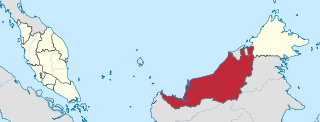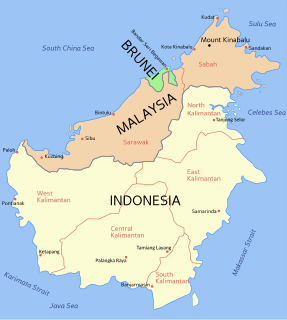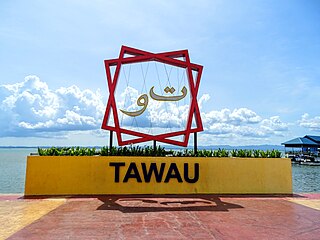
Lok-lok is a dish consisting of various steamboat style foods inclusive of meats and vegetables that are served on a skewer in mobile form. [1] [2]
Contents
It is a street food in Malaysia, in cities such as Penang, [3] Kuching, [4] among others.

Lok-lok is a dish consisting of various steamboat style foods inclusive of meats and vegetables that are served on a skewer in mobile form. [1] [2]
It is a street food in Malaysia, in cities such as Penang, [3] Kuching, [4] among others.

Sarawak is a state within Malaysia. The largest among the 13 states, with an area almost equal to that of Peninsular Malaysia, Sarawak is located in northwest Borneo Island, and is bordered by the Malaysian state of Sabah to the northeast, Kalimantan to the south, and Brunei in the north. The capital city, Kuching, is the largest city in Sarawak, the economic centre of the state, and the seat of the Sarawak state government. Other cities and towns in Sarawak include Miri, Sibu, and Bintulu. As of the 2020 census, the population of Sarawak was estimated over 2,907,500. Sarawak has an equatorial climate with tropical rainforests and abundant animal and plant species. It has several prominent cave systems at Gunung Mulu National Park. Rajang River is the longest river in Malaysia; Bakun Dam, one of the largest dams in Southeast Asia, is located on one of its tributaries, the Balui River. Mount Murud is the highest point in Sarawak.

East Malaysia, also known as Sabah, Sarawak and Labuan or Malaysian Borneo, is the part of Malaysia on and near the island of Borneo, the world's third largest island. It consists of the Malaysian states of Sabah and Sarawak, as well as the Federal Territory of Labuan. Labuan is an island in a small archipelago near the coast of Sabah. East Malaysia lies to the east of Peninsular Malaysia, the part of the country on the Malay Peninsula. The two are separated by the South China Sea.

The geography of Malaysia includes both the physical and the human geography of Malaysia, a Southeast Asian country made up of two major landmasses separated by water—Peninsular Malaysia to the west and East Malaysia to the east—and numerous smaller islands that surround those landmasses. Peninsular Malaysia is on the southernmost part of the Malay Peninsula, south of Thailand, north of Singapore and east of the Indonesian island of Sumatra; East Malaysia comprises most of the northern part of Borneo island, and shares land borders with Brunei to the north and Indonesian Borneo to the south.

Kuching, officially the City of Kuching, is the capital and the most populous city in the state of Sarawak in Malaysia. It is also the capital of Kuching Division. The city is on the Sarawak River at the southwest tip of the state of Sarawak on the island of Borneo and covers an area of 431 square kilometres (166 sq mi) with a population about 165,642 in the Kuching North administrative region and 159,490 in the Kuching South administrative region—a total of 325,132 people.

Kota Kinabalu, colloquially referred to as KK, is the state capital of Sabah, Malaysia. It is also the capital of the Kota Kinabalu District as well as the West Coast Division of Sabah. The city is located on the northwest coast of Borneo facing the South China Sea. The Tunku Abdul Rahman National Park lies to its west and Mount Kinabalu, which gave the city its name, is located to its east. Kota Kinabalu has a population of 452,058 according to the 2010 census; when the adjacent Penampang and Putatan districts are included, the metro area has a combined population of 628,725.

Sibu is an inland city in the central region of Sarawak. It is the capital of Sibu District in Sibu Division, Sarawak, Malaysia. The city is located on the island of Borneo and covers an area of 129.5 square kilometres (50.0 sq mi). It is located at the confluence of the Rajang and Igan Rivers, some 60 kilometres from the South China Sea and approximately 191.5 kilometres (119 mi) north-east of the state capital Kuching. Sibu is mainly populated by people of Chinese descent, mainly from Fuzhou. Other ethnic groups such as Iban, Malay and Melanau are also present, but unlike other regions of Sarawak, they are not as significant. The cities population as of 2010 is 162,676.

Miri is a coastal city in northeastern Sarawak, Malaysia, located near the border of Brunei, on the island of Borneo. The city covers an area of 997.43 square kilometres (385.11 sq mi), located 798 kilometres (496 mi) northeast of Kuching and 329 kilometres (204 mi) southwest of Kota Kinabalu. Miri is the second largest city in Sarawak, with a population of 300,543 as of 2020. The city is also the capital of Miri District of the Miri Division.

Bidayuh is the collective name for several indigenous groups found in southern Sarawak, Malaysia and northern West Kalimantan, Indonesia, on the island of Borneo, which are broadly similar in language and culture. The name Bidayuh means 'inhabitants of land'. Originally from the western part of Borneo, the collective name Land Dayak was first used during the period of Rajah James Brooke, the White Rajah of Sarawak. At times, they were also lesser referred to as Klemantan people. They constitute one of the main indigenous groups in Sarawak and West Kalimantan and live in towns and villages around Kuching and Serian in the Malaysian state of Sarawak, while in the Indonesian province of West Kalimantan they are mainly concentrated in the northern Sanggau Regency. In Sarawak, most of Bidayuh population can be found within 40 km of the geographical area known as Greater Kuching, within the Kuching and Serian Division. They are the second-largest Dayak ethnic group in Sarawak after the Iban and one of the major Dayak tribes in West Kalimantan.

Ais kacang, literally meaning "bean ice", also commonly known as ABC, is a Malaysian dessert which is common in Malaysia, Singapore and Brunei.

Sandakan formerly known at various times as Elopura, is the capital of the Sandakan District in Sabah, Malaysia. It is the second largest city in Sabah after Kota Kinabalu. It is located on the Sandakan Peninsula and east coast of the state in the administrative centre of Sandakan Division and was the former capital of British North Borneo. In 2010, the city had an estimated population of 157,330 while the surrounding municipal area had a total population of 396,290. The population of the municipal area had increased to 510,600 by 2020.

Tawau formerly known as Tawao, is the capital of the Tawau District in Sabah, Malaysia. It is the third-largest city in Sabah, after Kota Kinabalu and Sandakan. It is located on the Semporna Peninsula in the southeast coast of the state in the administrative centre of Tawau Division, which is bordered by the Sulu Sea to the east, the Celebes Sea to the south at Cowie Bay and shares a border with North Kalimantan, Indonesia. The town had an estimated population as of 2010, of 113,809, while the whole municipality area had a population of 397,673.

Motabbaq is a stuffed pancake or pan-fried bread which is commonly found in the Arabian Peninsula and Southeast Asia, notably in Saudi Arabia, Yemen, Indonesia, Malaysia, Singapore, Brunei, Thailand and Bangladesh. Depending on the location, the name and ingredients can significantly vary. The name mutabbaq in Arabic means "folded". It is a popular street food in Yemen, Indonesia, Malaysia, and Singapore.

Malaysia is a country in Southeast Asia. The federal constitutional monarchy consists of thirteen states and three federal territories, separated by the South China Sea into two regions, Peninsular Malaysia and Borneo's East Malaysia. Peninsular Malaysia shares a land and maritime border with Thailand and maritime borders with Singapore, Vietnam, and Indonesia. East Malaysia shares land and maritime borders with Brunei and Indonesia and a maritime border with the Philippines and Vietnam. Kuala Lumpur is the national capital, largest city and the seat of the legislative branch of the federal government. The nearby planned capital of Putrajaya is the administrative capital, which represents the seat of both the executive branch and the judicial branch of the federal government. With a population of over 32 million, Malaysia is the world's 44th-most populous country. The southernmost point of continental Eurasia is in Tanjung Piai. In the tropics, Malaysia is one of 17 megadiverse countries, home to numerous endemic species.

The Raj of Sarawak, also State of Sarawak, located in the northwestern part of the island of Borneo, was an independent state that later became a British Protectorate. It was established as an independent state from a series of land concessions acquired by an Englishman, James Brooke, from the sultan of Brunei. Sarawak received recognition as an independent state from the United States in 1850, and from the United Kingdom in 1864.

Bintulu is a coastal town on the island of Borneo in the central region of Sarawak, Malaysia. Bintulu is located 610 kilometres (380 mi) northeast of Kuching, 216 kilometres (134 mi) northeast of Sibu, and 200 kilometres (120 mi) southwest of Miri. With a population of 114,058 as of 2010, Bintulu is the capital of the Bintulu District of the Bintulu Division of Sarawak, Malaysia.

History of Sarawak can be traced as far as 40,000 years ago to the paleolithic period where the earliest evidence of human settlement is found in the Niah caves. A series of Chinese ceramics dated from the 8th to 13th century AD was uncovered at the archeological site of Santubong. The coastal regions of Sarawak came under the influence of the Bruneian Empire in the 16th century. In 1839, James Brooke, a British explorer, first arrived in Sarawak. Sarawak was later governed by the Brooke family between 1841 and 1946. During World War II, it was occupied by the Japanese for three years. After the war, the last White Rajah, Charles Vyner Brooke, ceded Sarawak to Britain, and in 1946 it became a British Crown Colony. On 22 July 1963, Sarawak was granted self-government by the British. Following this, it became one of the founding members of the Federation of Malaysia, established on 16 September 1963. However, the federation was opposed by Indonesia, and this led to the three-year Indonesia–Malaysia confrontation. From 1960 to 1990, Sarawak experienced a communist insurgency.

A delicacy is usually a rare and expensive food item that is considered highly desirable, sophisticated, or peculiarly distinctive within a given culture. Irrespective of local preferences, such a label is typically pervasive throughout a region. Often this is because of unusual flavors or characteristics or because it is rare or expensive compared to standard staple foods.
Dewi Liana Seriestha is a Malaysian singer, model as well as beauty pageant titleholder who was crowned Miss Malaysia World 2014. She represents her country at Miss World 2014 at London, United Kingdom where she placed as one of the Top 25 quarter-finalist and also became the first Malaysian to win the Miss World Talent award.
Sarawak exhibits notable diversity in ethnicity, culture, and language. The Sarawakian culture has been influenced by Bruneian Malays of the coastal areas. Substantial cultural influences also came from the Chinese and British cultures.